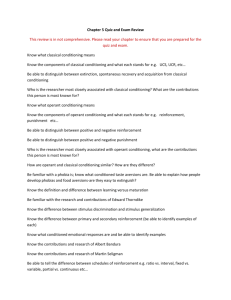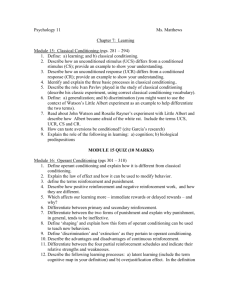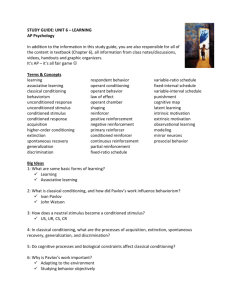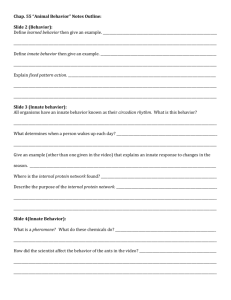AP Review - Learning
advertisement
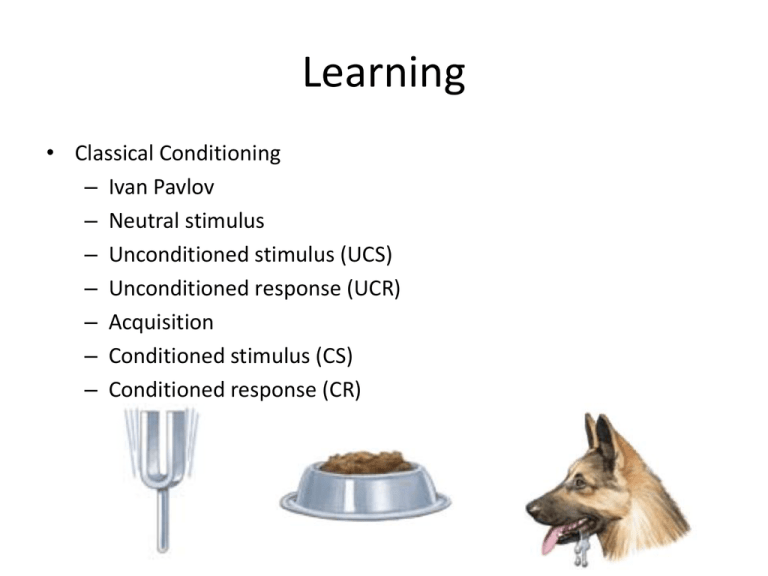
Learning • Classical Conditioning – Ivan Pavlov – Neutral stimulus – Unconditioned stimulus (UCS) – Unconditioned response (UCR) – Acquisition – Conditioned stimulus (CS) – Conditioned response (CR) Learning Learning • Operant Conditioning – B.F. Skinner – Positive and negative reinforcement – Contingencies of reinforcement – Schedules o reinforcement – Ratio or interval – Fixed versus variable Cognitive Learning • Insight learning - problem solving occurs by means of a sudden reorganization of perceptions – Wolfgang Köhler Cognitive Learning • Cognitive maps - mental representation of physical space – Edward Tolman Cognitive Learning • Albert Bandura Bobo doll experiment The type of learning in which association plays a major role is A. B. C. D. E. Classical conditioning Instinctual learning Operant conditioning Social learning Insight learning 83% 17% A. 0% 0% B. C. 0% D. E. When you learn to ignore the sound of traffic on the busy street where you live, you are exhibiting A. B. C. D. E. 100% Unlearning Habituation Conditioning Instinct Prompting 0% A. 0% B. C. 0% 0% D. E. You were conditioned to smile when you hear Christmas carols. During the summer, this response diminishes. However, in November when you hear these songs, you begin to smile again. In classical conditioning, the return of this response is known as A. B. C. D. E. Acquisition Extinction Reconditioning Spontaneous recovery Generalizations 92% 8% 0% A. 0% B. C. 0% D. E. You were frightened by a yellow cat when you were a child. Now you get scared whenever you see any cat. In classical conditioning, this response would be known as A. B. C. D. E. Spontaneous recovery Discrimination Generalization Insight Extinction 73% 27% 0% A. B. C. 0% 0% D. E. Your psychology professor gives several scheduled short quizzes and three scheduled tests throughout the semester. She is using a __________schedule of reinforcement. A. B. C. D. E. Fixed interval Variable ratio Variable interval Fixed ratio Continuous 56% 33% 11% 0% A. B. C. 0% D. E. Stimuli that fulfill basic needs and acts as a reinforce are called_______ reinforcers. A. B. C. D. E. 90% Secondary Natural Conditioned Primary Neutral 10% 0% A. 0% B. C. 0% D. E. Punishment is designed to ______ a behavior while negative reinforcement is designed to _______ a behavior. A. B. C. D. E. Increase, decrease Extinguish, repeat Highlight, emphasize Repeat, extinguish Decrease, increase 82% 18% 0% A. 0% B. C. 0% D. E. The lights in your house went out and it was pitch dark in your house. You were able to navigate to the kitchen because of a _______ map. A. B. C. D. E. Navigation Cognitive Memory Representation Environmental 92% 8% 0% A. B. C. 0% 0% D. E. You are in the grocery store waiting to check out. Your son cries because he wants candy. When you give in to his demands to make the tantrum stop, he has been ________. A. B. C. D. E. Positively reinforced Socially reinforced Negatively reinforced Positively punished Classical conditioning 55% 36% 9% 0% A. B. 0% C. D. E. Kohler’s study of chimpanzees suggests that they reorganize their perceptions, a mental process he called ______ learning. A. B. C. D. E. Operant Latent Classical Insight Perceptual 64% 18% 9% 9% 0% A. B. C. D. E. Jack learned how to shoot a free-throw by watching his older brother. Bandura called this ________ learning. A. B. C. D. E. Insight Latent Imitational Perceptual Observational 83% 8% A. 8% 0% 0% B. C. D. E. Studies of learning have shown that animals develop a aversion for tastes associated with… A. B. C. D. E. 67% Electric shock Extinguished association Sickness Novel stimuli Starvation 17% 8% 8% 0% A. B. C. D. E.






